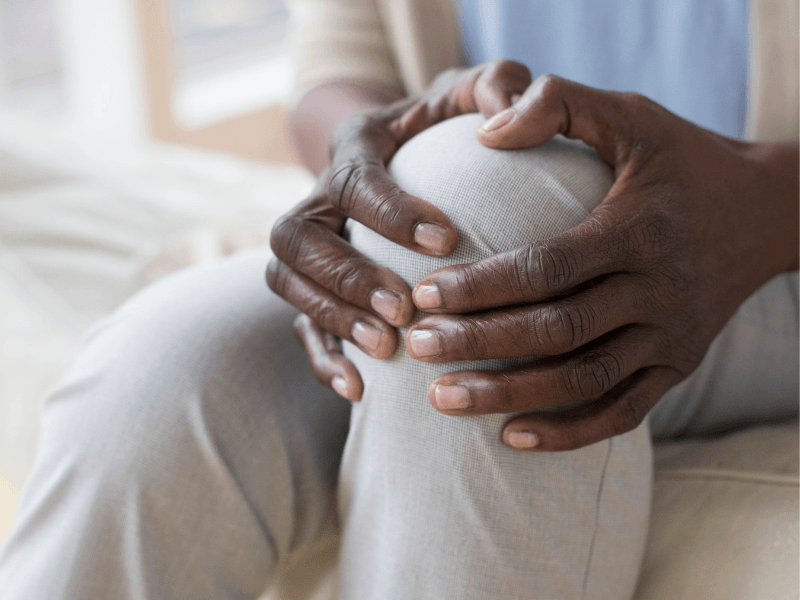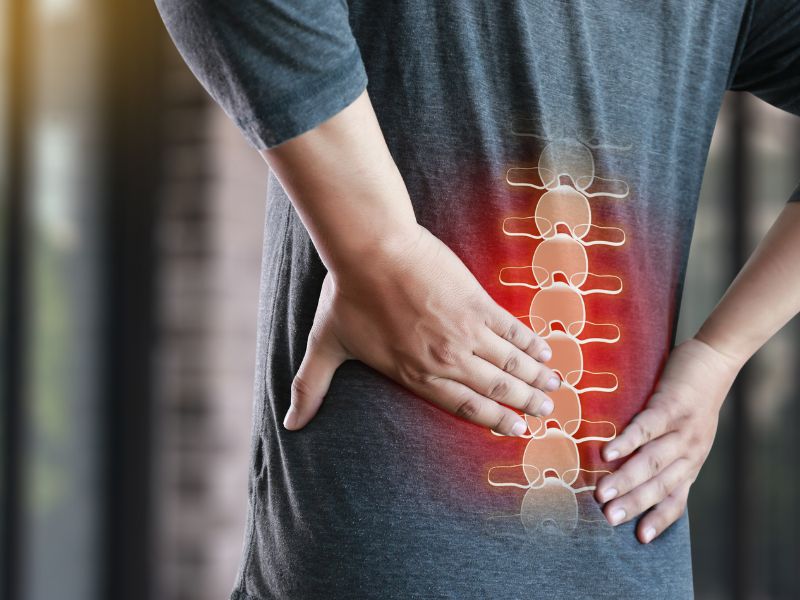Are you struggling to get a good night's sleep? Are you waking up with stiffness and joint pain that wasn't there before? It could be your mattress! Before you schedule a doctor's appointment or buy expensive medications, consider that your mattress could be the cause of your discomfort and beds like sleep number or alternatives might help. In this blog post, we'll take a look at the link between mattresses and joint pain and discuss how to determine if it's time to retire your old mattress and invest in a new one. Let's get started!
Quick Insight into Key Points
A bad mattress can indeed cause or worsen joint pain, as it can put added strain and pressure on the body. To minimize the risk of worsening existing joint pain, it is best to invest in a good quality mattress with adequate support for your health needs.
Poor Quality Mattresses and Joint Pain
The quality of your mattress can have a significant impact on joint pain. Poor quality mattresses can negatively affect both tissue and bone health, leading to an increase in discomfort and joint pain. When the springs and materials used to construct the mattress are low-grade, the support provided is far less than that of high-quality mattresses. Additionally, when springs are affected by rust or coils and don’t provide enough support, this too can cause joint pain from an increase in felt pressure points.
On one hand, many people believe that a soft mattress helps relieve pressure on joints, while some say that firmer mattresses are optimally beneficial for alleviating back pain. In fact, your mattress should offer strong support whether soft or firm.
Some say that a mattress that’s too soft doesn’t adequately support spine alignment and promotes muscle soreness, which can influence joint stiffness, making movement more difficult. While on the other hand, some say that extremely firm beds result in tossing and turning and an uncomfortable sleep surface. Ultimately, the firmness or softness of your bed doesn’t necessarily dictate the level of support it offers. The firmness is related to comfort and cushioning. For example, iSense adjustable firmness mattresses offer 20 different comfort settings from soft to firm, but retain the same level of support at each setting. So you never have to compromise support for comfort.
The kind of mattress deemed most comfortable is a personal preference but understanding what constitutes a poor quality mattress and how it affects joint pain is important in helping you make an informed decision when shopping for a bed.
It is important to be aware that poor quality mattresses can not only contribute to increased joint pain, but also limit the restorative powers of sleep as well. With so many different options available on the market today, it is easy to become overwhelmed when trying to decide which kind is right for you. In order to make sure you are getting the best value for your money and minimizing potential negative impacts on your health, it is recommended to buy from a reliable source and do proper research before committing to a particular brand or product type. Look for brands that have risk-free in-home trials so you can actually sleep on the mattress before committing to it fully.
As we endeavor to better understand how our sleep environment impacts not only comfort levels but also joint pain and muscle soreness, recognizing the role that mattresses play in overall well-being has become increasingly important. To better explore these factors further, it's useful to consider factors that influence joint pain and comfort - which we will discuss next.
- A study published in the Journal of Physical Therapy Science in 2017 found that sleeping on an unsupportive mattress had a negative effect on sleep quality, leading to increased pain and inflammation due to inadequate rest.
- A 2020 study published in Biomedical Reports concluded that poor sleep quality is linked to increased inflammation and higher levels of pain.
- According to the National Sleep Foundation, most mattresses should be replaced every 7-10 years in order to maintain back and joint health over time.
Factors that Influence Joint Pain and Comfort
When it comes to identifying potential sources of joint pain, the mattress is often a key factor. While different mattresses may vary in comfort level, certain elements have a direct influence on joint health, as well as the overall quality of sleep for those who suffer from chronic aches and pains. It’s important to understand which factors influence joint pain and comfort when it comes to selecting the right mattress for your needs.
Support is perhaps the most important factor influencing joint pain and comfort. Poor support can lead to poor posture while sleeping, resulting in unnecessary strain placed upon your joints. This can cause increased stress or musculoskeletal pain in areas such as the shoulders, lower back, hips, and neck upon waking up each morning. When a mattress supports the body correctly, these types of aches and pains are typically eliminated. If your mattress offers correct support, you will not experience harsh pressure points. Good support also promotes better circulation throughout the body during sleep, thus helping avoid issues related to improper alignment caused by pressure points or sinking into the mattress too deeply.
Another factor to consider is motion transfer which is the amount of motion felt on one side of the bed when another individual moves on their side of the mattress. This can be especially disruptive for those that share a sleeping space with someone else who moves frequently during sleep. Motion isolation technology helps reduce this effect by absorbing any movement thus limiting disturbance for individuals sharing beds. Some types of mattresses reduce motion isolation more than others.
Finally there’s temperature regulation which is another important consideration when selecting a mattress if you suffer from joint discomfort. Some types of foam are more prone to heat transfer than pocket coils alone and can build up excessive heat during use. For individuals who experience discomfort from overheating due to medical conditions like arthritis, it will be important to find a mattress that is designed with cooling materials that help keep surface temperatures at regulated levels throughout the night. However, this should always be considered before making a purchase as not all models possess this feature. iSense mattresses are built with open-cell foam, the most breathable foam on the market, and can also be treated with an added cooling component. These added cooling features can help with temperature regulation throughout the night to keep you comfortable.
In conclusion, choosing the right mattress primarily comes down to providing proper joint support while avoiding temperature buildup and motion transfer problems associated with uncomfortable sleeping positions.
When shopping for a new mattress it’s good practice to test out different models firsthand to determine if they offer an adequate level of support while still being comfortable enough to provide a good night’s rest. And the best way to test a mattress is to sleep on it for at least two weeks through an at-home trial. This is because testing out a mattress in the store while wide awake will help you test the level of comfort (i.e. softness or firmness), but sleeping on it will help you experience the kind of support the mattress offers. Once your body fully relaxes on the mattress, you will be able to determine in the morning whether it provided the support you need. Choosing a mattress company that offers risk-free, at-home trials and easy returns will help you be sure the mattress you choose is one you will enjoy for years to come.
Now that we have discussed factors that influence joint pain and comfort, let's move on to how poor mattress support can exacerbate existing musculoskeletal issues in our next section about poor mattress support.
Key Summary Points
When selecting a mattress, it is important to take into account the support level, motion transfer, and temperature regulation of the mattress in order to ensure the best quality of sleep for those suffering from chronic joint pain. Poor support can lead to improper posture and joints being placed under unnecessary stress resulting in increased pain. Motion transfer can disrupt sleep for those with shared beds, while temperature regulation is key for those with conditions like arthritis or hyperhidrosis. Be sure to sleep on your top-choice model before committing to determine if the mattress provides adequate support and comfort for an enjoyable, restful night's sleep.
Poor Mattress Support
Poor mattress support is one of the most common causes of joint pain. A mattress that doesn't provide adequate support can cause soreness, pressure points, and long-term chronic joint pain. To ensure adequate support for your body when sleeping, carefully consider what type of mattress you choose to sleep on.
The debate surrounding poor mattress support revolves around understanding the amount of firmness required for optimal comfort. For example, some people find that a firmer mattress is more comfortable and supportive while others may require more cushioning. Similarly, the question of whether or not a person should buy a new mattress often arises if they experience chronic joint pain. Some experts argue that there is no definitive answer regarding when to replace an old mattress, because each situation is different and dependent upon individual preference and needs. Joint pain can have a huge variety of causes, and thus, a variety of different kinds of support will be needed.
No matter which side of the debate you fall on, it can be beneficial to consult a doctor or physical therapist who specializes in back and joint health before investing in a new mattress. They can provide valuable insight regarding which type of joint pain you are experiencing and whether it might be chronic or acute. This information can help you choose a mattress that may be best for providing the necessary support and reducing pain levels for long-term joint health.
Therefore, poor mattress support - both too much and too little cushioning - can contribute to joint pain or make existing conditions worse. By seeking medical advice and finding the right level of support, individuals may be able to improve their overall health and enjoy greater levels of comfort when sleeping.
Finally, uncomfortable sleeping posture can also contribute to joint pain symptoms, so what type of sleep positioning might be best for those suffering from chronic aches? Read on to find out in the next section.
Uncomfortable Sleeping Posture
Uncomfortable sleeping posture, such as when one sleeps on an uneven or old and sagging mattress or with too many pillows, can contribute to joint pain. There are two sides to the argument about sleeping postures. Some medical professionals suggest that maintaining a proper posture while sleeping and replacing an old, lumpy mattress with a new, firm one can help alleviate joint pain and provide a better night’s rest. Others believe that uncomfortable or unhealthy sleeping postures are largely overstated. The answer may lie in the middle, as people often fall asleep in one position but move to different postures as they sleep throughout the night. And waking up with joint pain may indeed simply be due to the sagging or dips of an old mattress.
Regardless of which side of the argument you fall on, it is important to recognize the impact of posture and mattress type on comfort level during sleep. Staying in poor postures while lying in bed can cause misalignment in the spine and joints, potentially leading to further discomfort and pain. With that in mind, let’s explore how a bad mattress can cause joint pain.
How a Bad Mattress Can Cause Joint Pain
A bad mattress can cause joint pain, whether due to an old and decrepit mattress, or one that is overly firm or soft. People usually say different sleeping positions require different types of support. They say side sleepers need a softer mattress in order to reduce the pressure on their hips and shoulders, while back and stomach sleepers need more firm mattresses so that their spine can be properly aligned. However, it is actually the case that if your mattress provides the proper amount of pressure relief, the softness or firmness of the mattress should not actually matter as much. You should feel proper support for different sleep positions whether soft or firm.
Some suggest that poor quality mattresses made of low-quality foams over time can cause considerable discomfort, leading to increased joint inflammation and ultimately joint pain. These mattresses might be comfortable at first, but when sleeping, do not provide enough support. Specifically, lower-quality foam mattresses can sometimes become less responsive over time, leading to imbalances as they continually sink in certain areas depending on how they are used. This proves problematic in terms of providing proper support and comfort while minimizing physical stress inflicted due to posture irregularities.
Conversely, other experts believe that the primary culprit behind joint pain is not necessarily a bad mattress itself but rather incorrect sleeping posture or even improper pillows. People who are suffering from arthritis or recovering from a recent orthopedic surgery may find pre-existing conditions aggravated by mattresses regardless of type or quality. This means it is essential for those with medical issues to consult a doctor before investing in a new mattress. An adjustable firmness mattress such as those by iSense could be a solution for these individuals because an adjustable firmness mattress can adapt with their unique and changing health needs.
While a bad mattress may produce greater propensity for joint pain, it is far from being the only factor causing such malady. As such careful consideration should be given when selecting an appropriate and quality mattress based on individual needs, sleeping habits, and health considerations.
Finally, it is important to note that choosing a quality mattress is an important step towards reducing joint pain. In the next section we will look at tips for choosing a quality mattress, so you can get relief from your current joint discomfort and get a good night's rest.
Tips for Choosing a Quality Mattress
When it comes to selecting a quality mattress that will help reduce joint pain, there are certain features and elements to look for. There is ongoing debate as to whether firmness or contouring is more important in reducing joint pain. Firmness is often thought of as the ability of a mattress to not collapse or sink when pressure is applied, while conformity refers to the contouring of the mattress to the shape of the body, allowing for pressure relief across vulnerable body areas. It is likely a unique combination of these factors that will make the difference for individuals experiencing joint pain.
One side of the argument suggests that firmer mattresses are best for reducing joint pain, as softer mattresses can cause bodies to sink too far into them, which can lead to increased pressure being placed on joints. On the other hand, if a mattress is too firm it can cause uncomfortable pressure points which can lead to sleepless nights and an inability for the spine to find its natural alignment. For this reason, it is best to assume that neither firmness nor contouring itself leads to proper sleep, but effective head-to-toe support and pressure-relief.
Fortunately, advances in mattress technology have allowed customers more options when it comes to achieving a combination of comfortable contouring and necessary support. You can look for mattresses with features such as adjustable firmness levels made from different layers of foam or air-filled chambers that allow sleepers to customize their comfort based on personal preference and needs. The iSense Hybrid Premier offers adjustable firmness with pressure-relief at every setting. Each mattress is constructed to maintain a consistent level of support while creating adjustable levels of comfort through a proprietary combination of foam, individually-wrapped pocket coils and small, targeted air chambers.
An all-foam mattress is also a great option when looking for conforming support as it contours the body’s natural curves. The iSense Classic mattress combines different layers of premium, open-cell foam with small air chambers to create a contouring, adjustable experience. When choosing an all-foam mattress, keep an eye out for mattresses that use premium materials.
With all this in mind, you should now be well-equipped with straightforward advice on how to choose a quality mattress that will ensure sweet dreams without joint pain.
Conclusion
In conclusion, there is conflicting evidence on whether mattresses can cause joint pain. Some studies suggest that certain conditions such as allergies and poor sleeping posture can lead to joint discomfort, however it’s difficult to definitively pinpoint a mattress as the primary cause. Additionally, research suggests that changing an existing mattress to one with better support may improve sleeping posture and reduce pain. On the other hand, health factors such as advanced age or health conditions can also cause joint pain. There are many causes of joint pain, and the best way to find a mattress is to find one with support and comfort for your unique sleep needs.
Firm, medium and soft mattresses with durable support are the best place to start, depending upon what you prefer. If joint discomfort persists when sleeping on a firm mattress, it’s important to take into account lifestyle factors and wider health conditions before deciding what kind of mattress is best. Ultimately, each person's needs are different and it’s essential to discover what mattress suits their individual needs. In the end, you will need to consider the type of sleep surface that brings about the most comfort, with sufficient, pressure-relieving support for the back and joints.
Key Takeaways:
- There is conflicting evidence on whether mattresses can cause joint pain.
- Certain conditions such as allergies and poor sleeping posture can lead to joint discomfort.
- Testing out a variety of firmnesses of mattress with durable support could prove beneficial for those adjusting to new health conditions.
- It’s important to take into account lifestyle factors and wider health conditions before deciding what kind of mattress is best.
- Discover what mattress suits individual needs — consider the type of sleep surface that brings about the most comfort and provides adequate support for the back and joints.
Answers to Frequently Asked Questions
What types of mattresses are best for minimizing joint pain?
When it comes to selecting a mattress that minimizes joint pain, you want to find a mattress that distributes your weight evenly and reduces all pressure points. This could be soft or firm, but the level of pressure relief is what matters in the long run. Memory foam or a hybrid mattress with foam and coils can be beneficial in limiting joint pain as each can help to evenly distribute weight and provide optimal support for the body, reducing tension on tendons and joints. Finally, if you suffer from joint pain, you may want to choose a mattress with adjustable options so you can adjust the softness of your mattress depending on the level of comfort needed each night.
What are the signs that it's time to replace a mattress?
If you're experiencing chronic joint pain or discomfort during sleep, it could be a sign that it's time to replace your mattress. If you go to sleep pain-free and wake up sore, it is definitely a sign your mattress is likely to blame. Signs of an old, unsupportive mattress can also include sagging in the middle, lumpy sections, and an inability to make yourself comfortable no matter how much you move around. Additionally, if you're waking up with neck and back aches more regularly than usual, it's likely time for a new mattress. If your mattress is more than 10 years old, that's another sign that it might need replacing. Ultimately, if you suspect your mattress is causing any sort of physical pain, it's best to replace it with a new one that offers better support and more comfort. Always try to find a mattress with an at-home trial of at least two weeks so you can sleep on it and experience not only the level of comfort, but the level of full-body support.
What are other causes of joint pain besides a bad mattress?
Joint pain may be caused by many things, from injury and trauma to medical conditions such as arthritis. In addition to a bad mattress, other common causes of joint pain include:
- Osteoarthritis: Osteoarthritis is the most common form of arthritis and is characterized by progressive degeneration of the joints over time. Joints become inflamed, tender, and stiff as the cartilage between them gradually deteriorates. Osteoarthritis can affect any joint in the body but is most common in weight-bearing joints such as the knees, hips, spine, and feet.
- Rheumatoid Arthritis: Rheumatoid arthritis (RA) is an autoimmune disorder that occurs when your own immune system begins to attack healthy tissues. This chronic inflammatory disease causes joint swelling, stiffness, and pain. RA primarily affects the small joints in your hands and feet, but can also affect larger joints such as your shoulders, hips, and elbows.
- Injuries or Trauma: Joints can become painful following an injury or trauma due to inflammation of the tissue surrounding the joints. It could be caused from overuse from sports or exercise related activities, accidents like a fall or car accident or an injury sustained during work.
- Gout: Gout is a type of arthritis characterized by sudden and severe attacks of pain in one or more joints accompanied by redness, warmth, swelling and extreme discomfort. It is caused by too much uric acid in the blood which collects in the joints as sharp crystals causing inflammation.
- Tendonitis: Tendonitis occurs when tendons become inflamed due to overuse or repetitive motion activities that strain your tendons. Over time this becomes painful and can cause severe joint discomfort in areas like your knees and ankles that rely on your tendons for movement and stability.
In addition to these possible causes of joint pain there are many other conditions that could lead to joint pain such as lupus, fibromyalgia and some infectious diseases like Lyme disease. It's important to understand what might be causing your joint pain so you can properly address it with a doctor’s help.
An adjustable firmness mattress adapts with your changing health and wellness needs. iSense mattresses offer the same level of contouring, pressure-relieving support at all twenty comfort settings, from soft to firm. Try an iSense mattress risk-free for 180 days and experience comfort you can control.






















